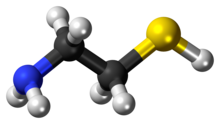Cysteamine

| |

| |
| Names | |
|---|---|
| Preferred IUPAC name
2-Aminoethane-1-thiol | |
| Other names
2-Aminoethanethiol
β-Mercaptoethylamine 2-Mercaptoethylamine Decarboxycysteine Thioethanolamine Mercaptamine | |
| Identifiers | |
3D model (JSmol)
|
|
| ChEBI | |
| ChEMBL | |
| ChemSpider | |
| DrugBank | |
| ECHA InfoCard | 100.000.421 |
| KEGG | |
PubChem CID
|
|
| UNII | |
CompTox Dashboard (EPA)
|
|
| |
| |
| Properties | |
| C2H7NS | |
| Molar mass | 77.15 g·mol−1 |
| Melting point | 95 to 97 °C (203 to 207 °F; 368 to 370 K) |
| Pharmacology | |
| A16AA04 (WHO) S01XA21 (WHO) | |
| Hazards | |
| Safety data sheet (SDS) | External MSDS |
Except where otherwise noted, data are given for materials in their standard state (at 25 °C [77 °F], 100 kPa).
| |
Cysteamine is the chemical compound with the formula HSCH2CH2NH2. It is the simplest stable aminothiol and a degradation product of the amino acid cysteine. It is often used as the hydrochloride salt, HSCH2CH2NH3Cl. The comparatively high melting point of cysteamine (95-97 °C), indicates that it exists in a salt form.[1]
Preparation
It can also be prepared by the reaction of ethylenimine with hydrogen sulfide.[1]
- (NHCH2CH2) + H2S → HSCH2CH2NH2
Reactions
It is used as the hydrochloride salt, as it readily oxidizes to the corresponding disulfide, in the presence of air. The amine portion of the molecule serves as a catalyst for this reaction.
- 4 HSCH2CH2NH2 + O2 → 2 NH2CH2CH2SSCH2CH2NH2 + 2 H2O
Biochemical and pharmaceutical applications
Under the trade name Cystagon, cysteamine is used in the treatment of disorders of cystine excretion. Cysteamine cleaves the disulfide bond with cystine to produce molecules that can escape the metabolic defect in cystinosis and cystinuria.
It is also used for treatment of radiation sickness.[2]
Cysteamine is used in the body to form the essential biochemical coenzyme A by combining with pantothenate and adenosine triphosphate.
In 2008, Raptor Pharmaceuticals started phase II clinical trials testing a delayed release (DR) preparation of cysteamine bitartrate for Huntington's disease. DR Cysteamine is also being investigated as a treatment for cystinosis, cystic fibrosis, Batten disease, and non-alcoholic steatohepatitis.
References
- ^ a b Reid, E. Emmet (1958). Organic Chemistry of Bivalent Sulfur. Vol. 1. New York: Chemical Publishing Company, Inc. pp. 398–399.
- ^ Lukashin BP, Grebeniuk AN (2001). "[Comparative study of the radiation-protective effectiveness of low doses of cysteamine, heparin, and naphtizine in experiments on mice]". Radiatsionnaia biologiia, radioecologiia / Rossiĭskaia akademiia nauk (in Russian). 41 (3): 310–2. PMID 11458646.
